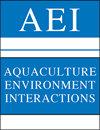Monitoring regional benthic environment of Norwegian salmon cage farms
IF 2.5
2区 农林科学
Q2 FISHERIES
引用次数: 0
Abstract
ABSTRACT: The influence of cage aquaculture on the benthic environment is a crucial concern for sustainable development. The impacts are affected by multiple environmental factors and aquaculture operations. Our main objective was to comprehensively analyze the interaction between Norwegian salmon aquaculture and the benthic environment, involving prolonged temporal observations and wide-ranging spatial assessments, achieved through reviewing government-regulated environmental assessment reports. A total of 3480 reports from 759 farms operating between 2016 and 2022 were analyzed. Our main finding was that the impact of Norwegian salmon cage aquaculture on the benthic environment varied significantly across the Northern, Central, and Southern regions (p < 0.001). This variability was significantly associated with factors such as water depth (p < 0.05), maximum allowable biomass density (p < 0.001), and length of the production cycle (p < 0.001), and was slightly correlated with current velocity (p = 0.067). Additionally, we observed that the most severe environmental degradation often occurred during the summer-autumn period under maximal annual feeding rates. Further, we traced 2922 reports to investigate the changes in the state of the benthic ecosystem over multiple production cycles. We found that the environmental impact of seafloor ecosystems was recoverable, with more effective recovery rates in the early stages of degradation compared to the later stages. We suggested that the optimal biomass levels, production cycle arrangement, and farming practices should differ depending on specific environmental factors. It is imperative to consider these factors for adapting farming operations and take early action when the benthic environment shows signs of degradation.监测挪威鲑鱼笼养场的区域海底环境
摘要:网箱养殖对海底环境的影响是可持续发展的一个重要问题。这种影响受到多种环境因素和水产养殖操作的影响。我们的主要目标是全面分析挪威鲑鱼养殖与底栖环境之间的相互作用,其中包括通过审查政府监管的环境评估报告,进行长时间的时间观察和大范围的空间评估。我们共分析了 2016 年至 2022 年期间 759 个养殖场的 3480 份报告。我们的主要发现是,挪威三文鱼网箱养殖对海底环境的影响在北部、中部和南部地区存在显著差异(p <0.001)。这种差异与水深(p <0.05)、最大允许生物量密度(p <0.001)和生产周期长度(p <0.001)等因素密切相关,并与水流速度略有关联(p = 0.067)。此外,我们还观察到,最严重的环境退化往往发生在年摄食量最大的夏秋季节。此外,我们还追踪了 2922 份报告,以研究多个生产周期中海底生态系统状态的变化。我们发现,海底生态系统对环境的影响是可以恢复的,与后期相比,退化初期的恢复率更高。我们建议,最佳生物量水平、生产周期安排和养殖方法应根据具体的环境因素而有所不同。必须考虑这些因素来调整养殖操作,并在海底环境出现退化迹象时尽早采取行动。
本文章由计算机程序翻译,如有差异,请以英文原文为准。
求助全文
约1分钟内获得全文
求助全文
来源期刊

Aquaculture Environment Interactions
FISHERIES-MARINE & FRESHWATER BIOLOGY
CiteScore
4.90
自引率
13.60%
发文量
15
审稿时长
>12 weeks
期刊介绍:
AEI presents rigorously refereed and carefully selected Research Articles, Reviews and Notes, as well as Comments/Reply Comments (for details see MEPS 228:1), Theme Sections and Opinion Pieces. For details consult the Guidelines for Authors. Papers may be concerned with interactions between aquaculture and the environment from local to ecosystem scales, at all levels of organisation and investigation. Areas covered include:
-Pollution and nutrient inputs; bio-accumulation and impacts of chemical compounds used in aquaculture.
-Effects on benthic and pelagic assemblages or processes that are related to aquaculture activities.
-Interactions of wild fauna (invertebrates, fishes, birds, mammals) with aquaculture activities; genetic impacts on wild populations.
-Parasite and pathogen interactions between farmed and wild stocks.
-Comparisons of the environmental effects of traditional and organic aquaculture.
-Introductions of alien species; escape and intentional releases (seeding) of cultured organisms into the wild.
-Effects of capture-based aquaculture (ranching).
-Interactions of aquaculture installations with biofouling organisms and consequences of biofouling control measures.
-Integrated multi-trophic aquaculture; comparisons of re-circulation and ‘open’ systems.
-Effects of climate change and environmental variability on aquaculture activities.
-Modelling of aquaculture–environment interactions; assessment of carrying capacity.
-Interactions between aquaculture and other industries (e.g. tourism, fisheries, transport).
-Policy and practice of aquaculture regulation directed towards environmental management; site selection, spatial planning, Integrated Coastal Zone Management, and eco-ethics.
 求助内容:
求助内容: 应助结果提醒方式:
应助结果提醒方式:


